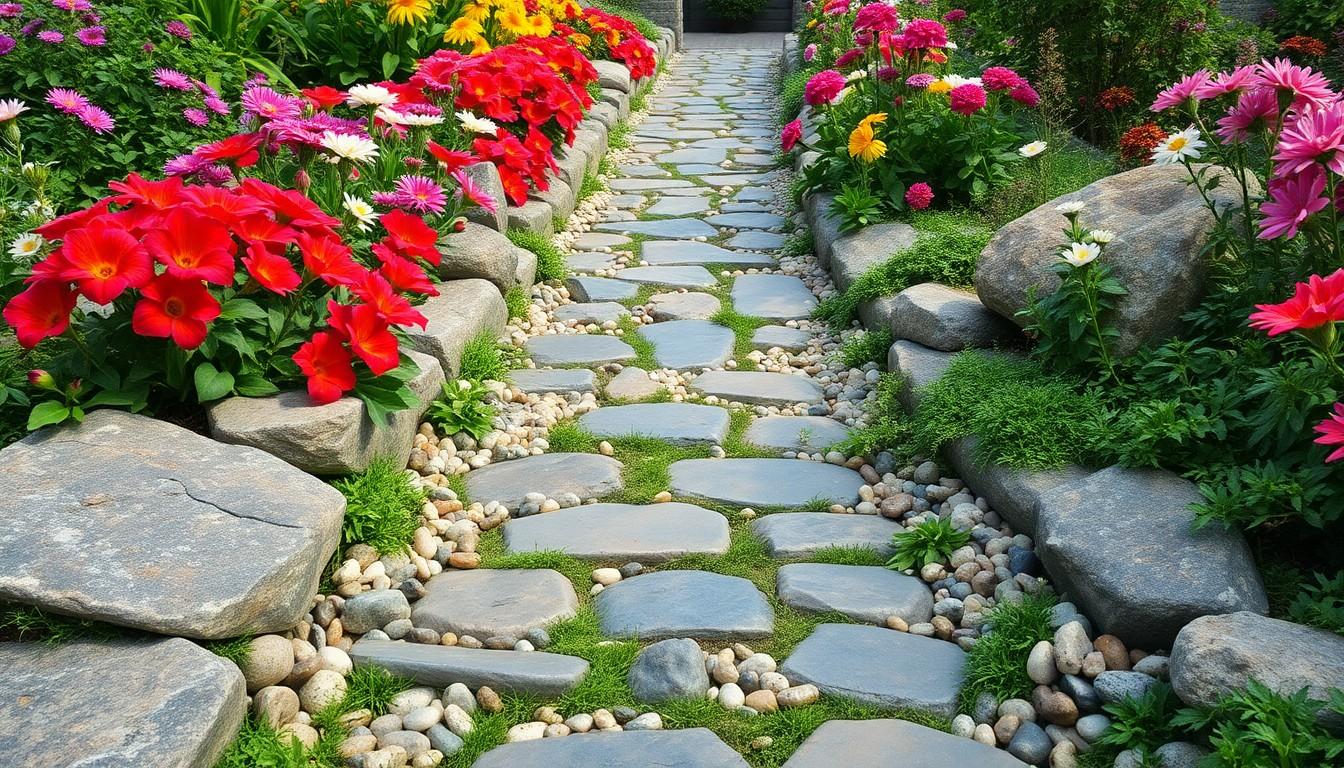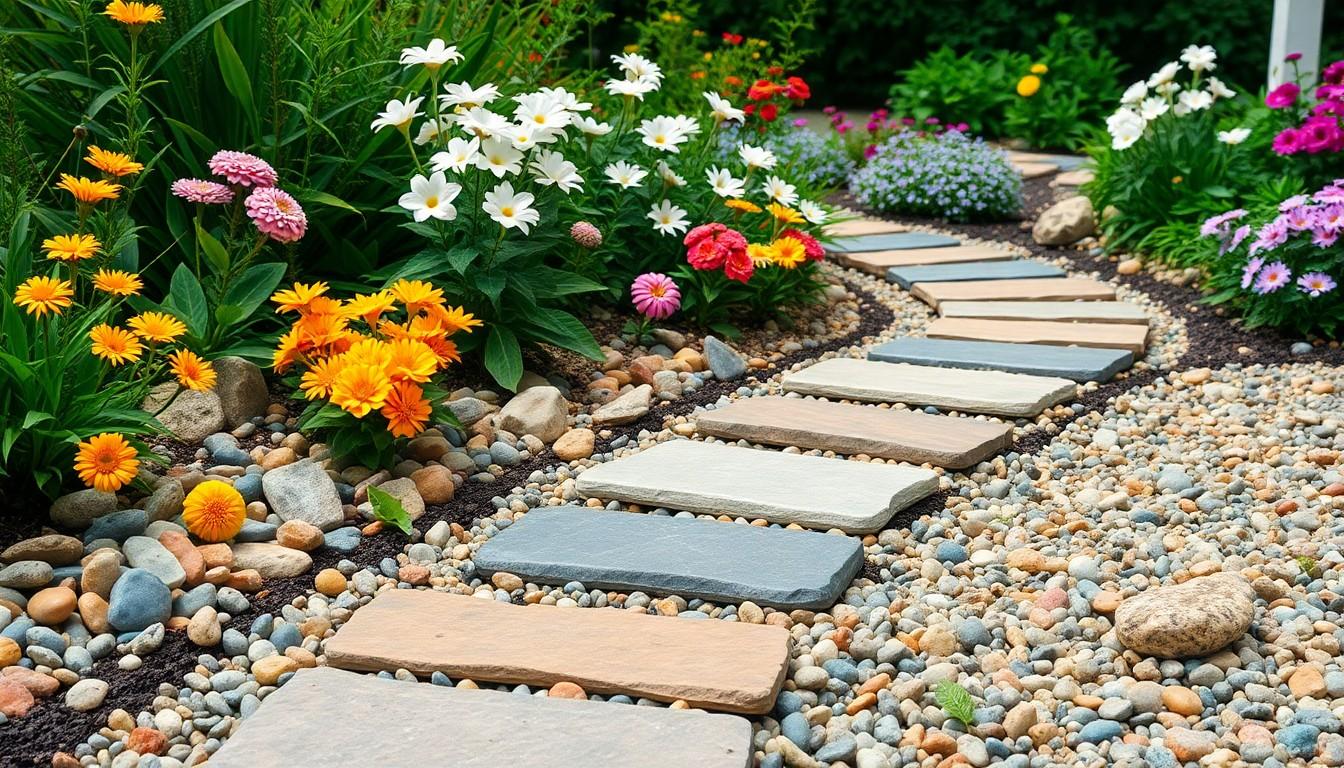Gardening isn’t just about plants; it’s a canvas where creativity meets nature. Enter gardening stones—the unsung heroes of outdoor aesthetics. These versatile gems can transform a mundane garden into a stunning masterpiece. From decorative pebbles to functional stepping stones, they add flair and functionality in ways that might just make your neighbors green with envy.
Overview of Gardening Stones
Gardening stones serve multiple purposes, making them a valuable addition to any landscape. A variety of types exist, including decorative pebbles, gravel, slate, and stepping stones. Each type contributes uniquely to a garden’s design and function.
Decorative pebbles enhance visual appeal, adding color and texture under plants or along pathways. Decorative stones come in various shapes, sizes, and colors, allowing for creative arrangements. Gravel, on the other hand, creates a rustic look while providing excellent drainage. The versatility of gravel enables its use in driveways, garden paths, or as a base for larger stones.
Stepping stones improve accessibility, allowing people to traverse a garden safely and comfortably. These stones can align in straight lines or take on more organic, whimsical shapes. They provide thoughtful pathways that guide visitors through flower beds and vegetable patches.
Natural stone options, such as slate and sandstone, bring organic beauty and durability. They can withstand weather changes and do not require frequent replacement. Additionally, larger rocks can serve as focal points, drawing the eye and breaking up monotonous landscapes.
Maintenance requirements for gardening stones vary. Decorative pebbles may only need occasional cleaning, while gravel can compact over time, requiring replenishment. Stepping stones typically require periodic adjustments, ensuring they remain level and accessible.
Overall, gardening stones combine aesthetic and functional benefits. They create inviting spaces, increase property value, and facilitate garden navigation. Selecting the right type of stone allows for creative expression and enhances overall garden design.
Types of Gardening Stones

Gardening stones come in various forms, each adding unique characteristics to outdoor spaces. Understanding the differences can help boost both aesthetics and functionality.
Natural Stones
Natural stones, including slate, sandstone, and limestone, often enhance a garden’s organic beauty. These materials showcase unique textures and colors, fitting well into various landscaping themes. Slate stands out for its durability and smooth surfaces, making it a popular choice for pathways. Sandstone offers warm hues and a rustic feel, suitable for decorative walls or patios. Maintenance for natural stones can be minimal, though occasional cleaning may be necessary to maintain their beauty.
Decorative Stones
Decorative stones serve both aesthetic and practical purposes in gardens. Varieties such as colored pebbles, gravel, and river rocks present options for filling flower beds or creating borders. Colored pebbles add vibrant accents that contrast beautifully with plants and flowers. Gravel provides a textured ground cover while promoting excellent drainage, preventing water accumulation. River rocks, with their polished appearance, can be used to enhance water features or garden pathways. Regular maintenance of decorative stones includes occasional rinsing to remove debris and restoring their original luster.
Benefits of Using Gardening Stones
Gardening stones provide various benefits that enhance both the visual and practical aspects of outdoor spaces. These stones contribute significantly to the overall effectiveness of garden design.
Aesthetic Appeal
Aesthetic appeal stands out as one of the primary benefits of using gardening stones. Decorative pebbles come in a wide array of colors and textures, allowing for creative landscaping options. Natural stones like slate and sandstone add authenticity and warmth to garden areas. These stones capture light beautifully, creating stunning visual effects in sunlight. Combining different stone types introduces variety, giving gardens a unique, personalized touch. The strategic placement of stepping stones can also create visual pathways, guiding the eye and enhancing the garden’s overall design.
Functional Advantages
Functional advantages significantly enhance the usability of gardens through the strategic use of stones. Gravel offers excellent drainage, preventing water accumulation around plants. Stepping stones provide a safe pathway, allowing easy access to various areas of the garden without damaging plant life. Natural stones such as limestone deliver durability, withstanding different weather conditions and reducing maintenance needs. Decorative stones function as ground cover, helping to suppress weeds while promoting soil moisture retention. These functional benefits ensure that gardening stones serve both aesthetic and practical purposes, making them essential elements in garden design.
Choosing the Right Gardening Stones
Selecting the appropriate gardening stones requires careful consideration of various factors affecting design and functionality.
Considerations for Size and Shape
Size plays a crucial role in the visual impact of the garden. Large stones can serve as focal points, while smaller stones often complement flora and enhance pathways. Stepping stones should provide enough surface area for safe foot placement, preventing slips. Irregular shapes lend a natural look, while geometric stones can create a structured appearance. Planning stone placement allows for better integration with plants and surrounding features. The spacing between stones impacts aesthetics and navigation—too far apart can hinder accessibility, while too close can appear cluttered.
Color and Texture Selection
A diverse palette of colors enhances the garden’s aesthetic charm. Earthy tones of natural stones blend with greenery, while vibrant pebbles add a lively touch. Selecting complementary hues ensures a harmonious appearance. Texture also plays a vital role; rough surfaces contrast beautifully with soft foliage. Smooth stones can reflect light and create a polished look, while matte finishes emphasize a more rustic feel. Combining different colors and textures enriches visual interest, making the landscape more dynamic. Balanced selection creates an inviting atmosphere, encouraging exploration and appreciation of the garden’s beauty.
Maintenance of Gardening Stones
Regular maintenance ensures gardening stones remain attractive and functional. Cleaning decorative pebbles boosts their visual appeal. A simple rinse with water eliminates dirt and debris, maintaining their vibrant colors. Gravel requires periodic replenishment to retain its rustic look and drainage properties. When gravel settles or gets compacted, adding fresh material restores its functionality.
For natural stones like slate or sandstone, occasional cleaning with a soft brush prevents the buildup of algae and moss. Ensuring these stones are free from organic growth enhances their natural beauty. Moreover, inspecting stepping stones for cracks or shifting ensures safety and accessibility. Repairing or replacing damaged stones quickly minimizes risks.
Weed suppression is another essential aspect of garden stone maintenance. Decorative stones effectively reduce weed growth, but occasional weeding might still be necessary. Hand-pulling weeds or using a hoe removes unwanted plants while preventing damage to nearby stones.
Monitoring drainage areas also helps maintain functionality. Ensuring gravel or pebbles remain loose prevents water pooling and promotes healthy soil moisture. During heavy rainfall, checking drainage pathways ensures stones guide water efficiently away from plants.
Lastly, seasonal adjustments can enhance aesthetic appeal. Integrating seasonal flowers around stones creates visual interest, drawing the eye to their natural beauty. Each season presents a chance to refresh the garden’s look, making stones a focal point.
Taking these maintenance steps preserves the elegance and functionality of gardening stones, contributing to an inviting outdoor space.
Conclusion
Gardening stones offer a unique blend of beauty and practicality that transforms outdoor spaces. Their diverse range of colors shapes and textures allows for endless creative possibilities in garden design. By carefully selecting and strategically placing these stones gardeners can enhance both the aesthetic appeal and functionality of their landscapes.
Regular maintenance ensures that these stones continue to shine while serving their purpose. Whether it’s the vibrant hues of decorative pebbles or the natural charm of slate and sandstone each type of stone plays a vital role in creating an inviting atmosphere. Embracing gardening stones not only elevates the garden’s beauty but also fosters a deeper connection with nature inviting exploration and appreciation.

